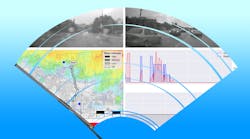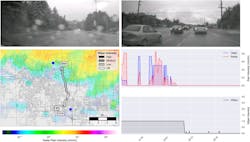Windshield Wipers More Accurate than Weather Radar for Monitoring Rainfall
Engineers at the University of Michigan have added some serious tech to automotive windshield wipers, building a mobile network more accurate than weather radar at tracking and monitoring local rainfalls. The team networked a small test fleet of cars in Ann Arbor so that it could track where the cars were and if they had their wipers on; cameras were also added so the team could see and gauge rainfall.
The engineers tracked when wipers were being used, matching that data with video from onboard cameras to document rainfall. They found that tracking windshield wiper activity can provide faster, more accurate rainfall data than radar and rain gauges currently in place.
Water departments and city managers armed with such real-time data could move more quickly to prevent flash-flooding or sewage overflows and make better use of “smart” stormwater systems outfitted with autonomous sensor and valves. Local flooding represents a rising threat to property, infrastructure, and the environment.
“Networked vehicles such as these offer a way to get rainfall information at resolutions we’d not seen before,” says Branko Kerkez, a UM engineering professor. “It’s more precise than radar and lets us fills gaps in existing rain gauge networks.”
Analysis of a single vehicle trip occurring 21:46 to 22:26 on Aug. 11, 2014. The top two panels show video footage during the trip’s rainy (left) and dry (right) segments. The bottom left panel maps the vehicle’s trip, with wiper intensity indicated by color. A radar overlay shows average rainfall intensity over the 40-minute period. Blue circles represent the gauges nearest to the vehicle path. The two bottom right panels show precipitation intensity as estimated by radar and gage measurements (center), and the 1 min. average wiper intensity (bottom). (Courtesy: Scientific Reports)
The best current warnings for flood conditions come from the combination of satellite radar tracking and rain gauges spread over a wide geographic area. Both have poor spatial resolution, meaning they cannot capture what’s happening at street level.
“Radar has a spatial resolution of a quarter of a mile and a temporal resolution of 15 min.,” says Ram Vasudevan, another UM engineering professor. “In contrast, wipers have spatial resolutions of a few feet and temporal resolutions of a few seconds, which can make a huge difference in predicting flash flooding.”
Earlier this year, the European Academy of Sciences reported the number of floods and extreme rainfall events increased by more than 50% this decade and happen four times more often than they did in 1980.
“Because of the sparseness of radar and rain gauge data, we don’t have enough information about where or when it is raining,” Vasudevan explains. “If you have fine-grain predictions of where there is flooding, you can efficiently and effectively control water networks to prevent all sorts of dangerous chemicals from contaminating our water supply due to runoff.”
Creating a blanket of sensors across a city for street-level data on rain events would be costly. But using connected vehicles taps a resource that can be easily put in place now and will only grow larger in the future as more cars are added into the IoT.
Researchers collected data from a set of 70 cars outfitted with sensors embedded in windshield wipers and dashboard cameras. That program, called Safety Pilot, was the world’s largest connected vehicle test program with roughly 3,000 participants. It is now called the Ann Arbor Connected Vehicle Test Environment.
Kerkez and Vasudevan say their research represents the first step in creating a smart infrastructure network fed by and responding to data collected from vehicles on the road. But more work will be needed to bring the concept to fruition.
“One day, when everything is connected, we’re going to see the benefits of this data collection at a system scale,” Kerkez says. “Right now, we’ve made connections between cars and water, but there will surely be more examples of data sharing between interconnected infrastructure systems.”


